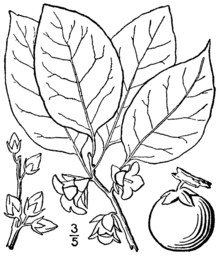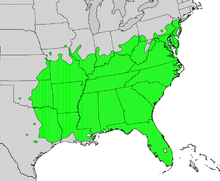| Diospyros virginiana | |
|---|---|

| |
| Botanical details of buds, flowers and fruit | |

| |
| Scientific classification | |
| Kingdom: | Plantae |
| Clade: | Tracheophytes |
| Clade: | Angiosperms |
| Clade: | Eudicots |
| Clade: | Asterids |
| Order: | Ericales |
| Family: | Ebenaceae |
| Genus: | Diospyros |
| Species: | D. virginiana
|
| Binomial name | |
| Diospyros virginiana | |

| |
| Distribution map of the American persimmon | |
| Synonyms[3] | |
|
Diospyros mosieri S.F.Blake | |
Diospyros virginiana is a persimmon species commonly called the American persimmon,[3] common persimmon,[4] eastern persimmon, simmon, possumwood, possum apples,[5] or sugar plum.[6] It ranges from southern Connecticut to Florida, and west to Texas, Louisiana, Oklahoma, Kansas, and Iowa. The tree grows in the wild but has been cultivated for its fruit and wood since prehistoric times by Native Americans.
Diospyros virginiana grows to 20 m (66 ft), in well-drained soil. The tree is typically dioecious, so one must have both male and female plants to obtain fruit. Most cultivars are parthenocarpic (setting seedless fruit without pollination). The fragrant flowers are pollinated by insects and wind. Fruiting typically begins when the tree is about 6 years old.
The fruit is round or oval and usually orange-yellow, sometimes bluish, and from 2 to 6 cm (3⁄4 to 2+1⁄4 in) in diameter. Both the tree and the fruit are referred to as persimmons, with the latter appearing in desserts and cuisine in the U.S. South and Midwest.
Commercial varieties include the very productive Early Golden, the productive John Rick, Miller, Woolbright and the Ennis, a seedless variety. Another nickname of the American persimmon, 'date-plum' also refers to a persimmon species found in South Asia and South Europe, Diospyros lotus. Today, persimmons are also grown on small farms as a heritage crop.[7]
- ^ "NatureServe Explorer 2.0 - Diospyros virginiana, Persimmon". explorer.natureserve.org. Retrieved 6 May 2020.
- ^ IUCN SSC Global Tree Specialist Group & Botanic Gardens Conservation International (BGCI) (2021). "Diospyros virginiana". IUCN Red List of Threatened Species. 2021: e.T173405A152905371. doi:10.2305/IUCN.UK.2021-2.RLTS.T173405A152905371.en. Retrieved 11 October 2022.
- ^ a b "Diospyros virginiana". Germplasm Resources Information Network. Agricultural Research Service, United States Department of Agriculture. Retrieved 16 December 2017.
- ^ NRCS. "Diospyros virginiana". PLANTS Database. United States Department of Agriculture (USDA).
- ^ Karp, David (2000-11-08). "Know Your Persimmons". Los Angeles Times. Retrieved 12 November 2017.
- ^ Phillips, Jan (1979). Wild Edibles of Missouri. Jefferson City, Missouri: Missouri Department of Conservation. p. 40.
- ^ Eddy, Kristin (22 November 1998). "One Peculiar Pudding". Chicago Tribune.

